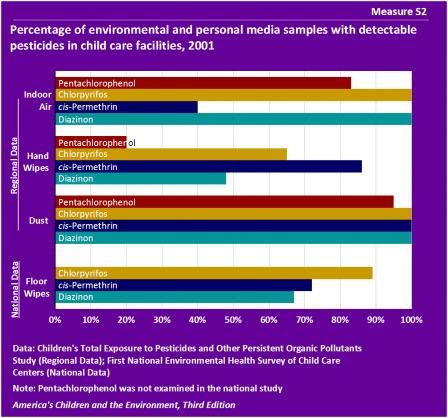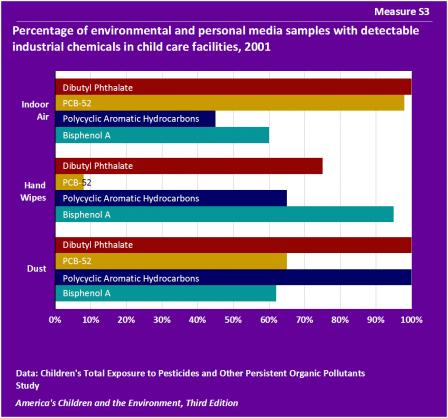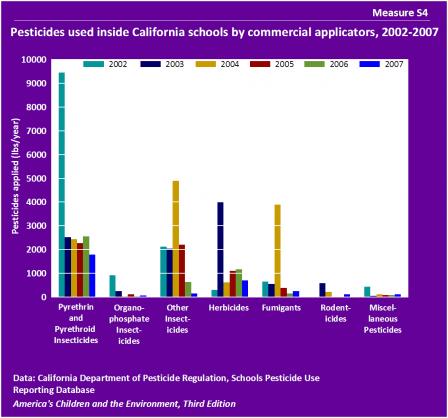ACE: Supplementary Topics - Contaminants in Schools and Child Care Facilities
Indicator S2

Data characterization
- National data for this measure were obtained from a federal government study of a nationally representative sample of 168 child care centers. Pesticides were measured in environmental samples collected from the child care centers.
- Regional data for this measure were obtained from an EPA study of 29 child care centers in Ohio and North Carolina. Pesticides were measured in environmental samples collected from the child care centers and from the hands of children in the centers.
- Chlorpyrifos, cis-permethrin, and diazinon were detected in all of the dust samples collected at Ohio and North Carolina child care centers included in the CTEPP study in 2000-2001. Chlorpyrifos and diazinon were also detected in all of the indoor air samples collected at these child care centers.
- Pesticide residues were detected least often in the hand wipe samples collected at the selected Ohio and North Carolina child care centers, but chlorpyrifos and cis-permethrin were detected in more than half of the hand wipe samples.
- The national level floor wipe sampling found chlorpyrifos most frequently, in 89% of samples. Cis-permethrin and diazinon were also detected frequently, in 72% and 67% of floor wipe samples, respectively. (Pentachlorophenol was not examined in the national study.)
Indicator S3

Data characterization
- Data for this measure were obtained from an EPA study of 29 child care centers in Ohio and North Carolina.
- Chemicals were measured in environmental samples collected from the child care centers and from the hands of children in the centers.
- Of the chemicals shown in this measure, dibutyl phthalate was the most frequently detected in indoor air and dust samples collected at Ohio and North Carolina child care centers included in the CTEPP study in 2000-2001.
- Dibutyl phthalate and PAHs (represented by benzo[b]fluoranthene) were detected in 100% of the dust samples. PCB-52 and bisphenol A were detected in 65% and 62% or dust samples, respectively.
- Dibutyl phthalate, PAHs, and bisphenol A were detected in more than 60% of hand wipe samples, while PCB-52 was detected in less than 10% of these samples.
- Dibutyl phthalate was detected in all of the indoor air samples and PCB-52 was detected in almost all (98%) of the samples. PAHs were detected in slightly less than half of the indoor air samples, while bisphenol A was detected in slightly more than half of the indoor air samples.
Indicator S4

Data characterization
- Data for this measure are obtained from a reporting database maintained by the California Department of Pesticide Regulation.
- Reporting is required for all pesticide applications by pest control companies at all school and childcare facilities in California.
- Pesticide reports are submitted to the database at least annually and report all pesticide application on any area of school or childcare facility property visited or used by pupils.
- Pyrethrin and pyrethroid insecticides accounted for the greatest volume of pesticide use in California schools overall from 2002 to 2007, although there was greater use of herbicides in 2003, and of the “other” insecticides category and fumigants in 2004.
- The application of pyrethrin and pyrethroid insecticides, and organophosphate insecticides inside California schools has decreased since 2002.
About the Contaminants in Schools and Child Care Facilities Measure
Measures S2, S3, and S4 present information about potential exposures of children to a variety of pesticides and industrial chemicals found in schools and child care centers. The data for measures S2 and S3 are from two federal studies that tested for pesticides and industrial chemicals in samples collected from child care facilities. The data for measure S4 are from a database for the state of California, which compiles information from all commercial pesticide applications in California schools.
- Measure S2 presents the percentage of environmental and personal media samples with detectable pesticides in child care facilities in 2001.
- Measure S3 presents the percentage of environmental and personal media samples with detectable industrial chemical in child care facilities in 2001.
- Measure S4 presents the amount of pesticides used inside California schools from 2002-2007.
The indoor and outdoor environmental quality of schools and child care facilities plays an important role in affecting children's health and academic performance. Depending on the type of facility and its particular characteristics (i.e., age, usage, and maintenance), children may be exposed to contaminants from a variety of indoor and outdoor sources. These potential exposures are of particular concern because children generally spend most of their active, awake time at schools and child care facilities.
Children may be exposed to a variety of contaminants in school and child care settings, such as lead, asbestos, polychlorinated biphenyls (PCBs), pesticides, brominated flame retardants, phthalates, and perfluorinated chemicals. Exposure to indoor contaminants can occur through multiple routes, such as through the skin, inhalation, and ingestion. These types of indoor environmental contaminants have been associated with a variety of adverse health outcomes, and also outcomes related to educational performance for which impaired health is a suspected cause. Many schools and child care facilities in the United States have problems with indoor environmental contaminants, and some children are especially susceptible to such exposures, like those with allergies, asthma, and other respiratory problems.
Measures S2 and S3 present data on children's potential exposures to pesticides and industrial chemicals from two federal studies: the Children's Total Exposure to Persistent Pesticides and Other Persistent Organic Pollutants (CTEPP) Study and the First National Environmental Health Survey of Child Care Centers. Measure S4 presents data on pesticides used in California schools from the California Schools Pesticide Use Reporting Database.
More information about contaminants in schools and child care facilities and Measures S2, S3, and S4 is provided in the Contaminants in Schools and Child Care Facilities section of America's Children and the Environment, Third Edition.
Related Links
California Department of Pesticide Regulation: Healthy Schools Act (PDF)
U.S. EPA: Asbestos in School Buildings
U.S. EPA: Creating Healthy Indoor Environments in Schools
U.S. EPA: Healthy Schools Environments
U.S. EPA: Integrated Pest Management (IPM) in Schools
Summary of Methods - Contaminants in Schools and Child Care Facilities
The Children's Total Exposure to Persistent Pesticides and Other Persistent Organic Pollutants (CTEPP) Study was a regional study conducted by EPA at 29 child care centers in North Carolina and Ohio in 2000-2001. The CTEPP study investigated the potential exposures of the preschool children and their adult child care providers to pesticides and chemicals. Environmental (indoor and outdoor air, carpet house dust, and soil) and personal (hand wipe, solid and liquid food, drinking water, and urine) samples were collected at the child care center and analyzed for over 50 chemicals, including pesticides, PAHs, PCBs, phthalates, and phenols.
The First National Environmental Health Survey of Child Care Centers was conducted by the U.S. Department of Housing and Urban Development, the Consumer Product Safety Commission, and EPA in 2001. Indoor and outdoor environmental media samples (surface wipes and soil samples) from a nationally representative sample of 168 child care centers were tested for lead, allergens, and pesticides.
Measure S2 uses the CTEPP and The First National Environmental Health Survey of Child Care Centers data to present the percentage of environmental and personal media samples taken from selected regional and national child care facilities with detectable pesticides. Measure S3 uses the CTEPP data to present the percentage of environmental and personal media samples taken from selected regional child care facilities with detectable industrial chemicals.
Data shown in these measures from the two federal studies were obtained directly from these sources:
Tulve, N.S., P.A. Jones, M.G. Nishioka, R.C. Fortmann, C.W. Croghan, J.Y. Zhou, A. Fraser, C. Cave, and W. Friedman. 2006. Pesticide Measurements from the First National Environmental Health Survey of Child Care Centers Using a Multi-Residue GC/MS Analysis Method. Exit Environmental Science and Technology 40(20) 6269-6274.
Morgan, M.K., L.S. Sheldon, C.W. Croghan, J.C. Chuang, R.A. Lordo, N.K. Wilson, C. Lyu, M. Brinkman, N. Morse, Y.L. Chou, C. Hamilton, J.K. Finegold, K. Hand, and S.M. Gordon. 2004. A Pilot Study of Children's Total Exposure to Persistent Pesticides and Other Persistent Organic Pollutants (CTEPP), Appendix I and Appendix J. Research Triangle Park, NC: U.S. Environmental Protection Agency. U.S. EPA: Protecting Children's Health: An EPA Study Measures the Levels of Commonly Used Chemicals in Homes and Day Care Centers.
The California Department of Pesticide Regulation collects data on all commercial pesticide application in California schools. In the year 2000, California passed the Healthy Schools Act of 2000, which required all public child care facilities and school sites to report pesticide use on school sites by pest control businesses. The Act requires reporting for application of pesticides to the buildings or structures (including attics and crawl spaces), playgrounds, athletic fields, school vehicles, or any other area of school property, indoors and outdoors, visited or used by pupils.
Measure S4 uses the California Schools Pesticide Use Reporting Database data to present the annual amount (pounds per year) of pesticides used inside California schools and child care facilities by commercial applicators.
Detailed Methods for Measure S4
Metadata for California Schools Pesticide Use Reporting Database
